The predawn darkness is silent and clear, and the crisp cold is starting to freeze the tip of your nose. This is Yellowstone in winter. You’ve been waiting an hour for some sign that the wolves are indeed here. They could be right in front of you but in the murky blackness there is nothing to see, only the vague outlines of tall mountain peaks in the distance. You are about to give up and head back to the warmth of the not so warm car. Then it starts. A lone wolf howl. Your eyes widen.
That low howl is then joined by other voices, a group howl that bonds a wolf pack together and prepares them for their daily chores. The howl brings your cold blood back to life, and a smile appears on your face. As the morning light starts to trickle in, a shape moves at the corner of your eye. There they are, the wolves.
We made this video during our last visit to Yellowstone in winter. We stayed for a week and had great luck with our wildlife sightings as we found the best places to see wildlife in Yellowstone in winter.
*This article may contain affiliate links. We receive a small commission at no extra cost to you.*
The Wolves of Yellowstone
The howl of a wolf is probably the definitive sound of the American wilderness. And that’s why you travel to Yellowstone in winter; to see and hear wolves.
Yellowstone is without a doubt one of the premier wildlife destinations in the world. It is legendary. Yellowstone National Park was established in 1872 as the United States‘ first national park. Yellowstone is also the world’s first national park.
Over the years, Yellowstone conservation work has become an example to follow.
In 1900, only 23 indigenous bison lived in the Pelican Valley of central Yellowstone, having almost been extirpated. In 1902, another herd was created with 3 male bison from Texas and 18 female bison from northern Montana. Their protection and husbandry allowed the bison to expand to more than 1,500 individuals in 1954. Today, there are around 4,900 bison in Yellowstone.
Then, exactly 20 years ago, wolves were reintroduced to the Yellowstone ecosystem. The Yellowstone wolf reintroduction is possibly the most famous wildlife reintroduction in the world.
With the return of the wolf, Yellowstone was finally complete again.
Today, 400-450 wild wolves roam free in the Yellowstone ecosystem. Seeing wolves in Yellowstone is a dream for many wildlife watchers. And you can make this dream come true by joining a Yellowstone wolf tour or visit the park independently.
These are our recommendations on how to see wolves in Yellowstone in the winter:
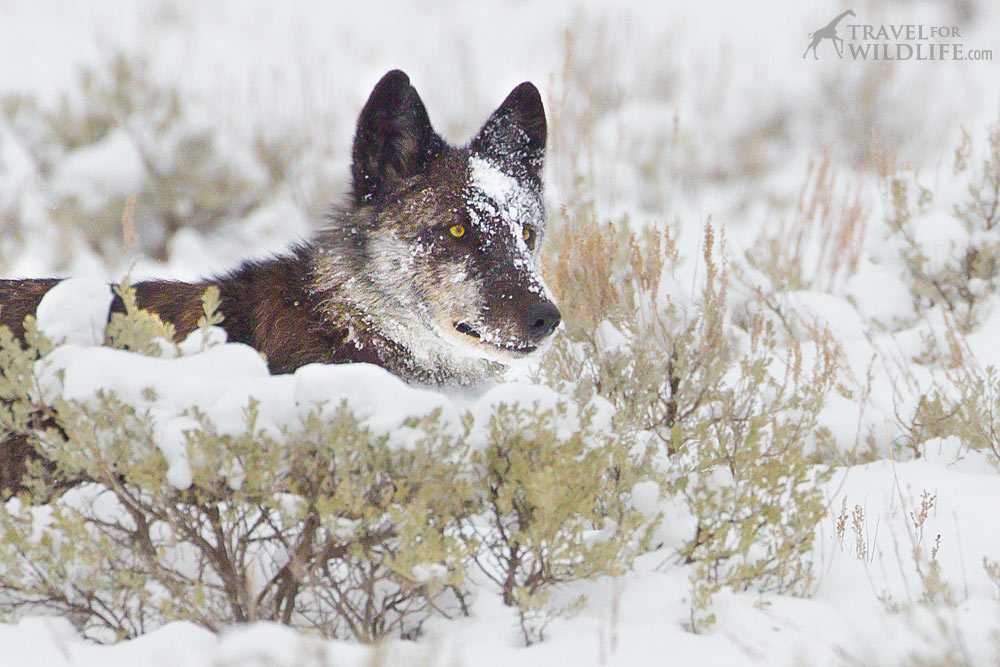
How to Spot Wolves in Yellowstone?
You might be lucky and see a wolf cross the road in front of you. But for the other 99.9% of the time, you need to work for a good wolf sighting.
Here are our tips on how to find wolves in Yellowstone:
1) Get up early. Like really early. Be down at the Lamar Valley by 7am. We like to get there just before sunrise; this is the time when the wolves get active and if they’ve made a kill by the Lamar River or the Soda Butte Creek, you’ll have a great sighting. Our favorite place to stop was at the Lamar River trail head pullout. If the wolves are up the hill, you’ll be able to see them with the naked eye as it’s not that far away. Visibility is great.
2) Keep an eye out for wolf researchers. They are really nice and if you ask them a question they’ll be super nice about it. They’ll even let you look through their scopes. You can ask them questions, but don’t bother them too much. They are working.
3) Watch ravens and other corvids like crows and magpies. They love to follow wolves around and if you see a group of them flying around being very noisy, there might be a kill nearby. Wait and watch. They might lead you to the wolves.
4) If you see an elk standing in a river, it means a wolf is nearby. Elk have a survival strategy of standing in a freezing cold river as they know a hunting wolf won’t follow them there.
5) Ask other wildlife watchers about their sightings. Normally people are really nice about it and we’ve made great friends over the years by asking others about their sightings. Also, if people ask you, be nice about it and tell them. You never know, perhaps next year you’ll meet these people in Botswana and they’ll take you to your best leopard sighting ever!
6) When you enter the park, go to the Visitor Center located in Mammoth Hot Springs and purchase the Wolf Identification Chart produced by A Naturalist’s World with the help of the Wolf Project. This is a visual guide with photos of individual wolves and a listing of all known members of the wolf packs of Yellowstone. It also shows their territories within the park. Take a look at this map and figure out where more than two packs share their boundaries. If it’s close to a road you will have more possibilities to see a pack along that bit of road. When we visited, two packs were having a boundary dispute and we saw them pretty close to the road along with a few territorial markings like urine and scratching.
7) The easiest/laziest way of all is to look for crowds. If there are more than a dozen people with spotting scopes, then there is clearly a wolf in the vicinity. Occasionally these huge crowds can affect wolf behavior, like the morning we spotted the alpha female of the Lamar Canyon pack attempting to hunt in the valley nearby. As a huge crowd of onlookers approached, the shy wolf retreated back toward the hills. Use your best judgement at a sighting and try not to contribute to mobbing.
8) Listen! Stop the car every once in a while, get out of the car and listen. We found a pack of wolves by listening. They were right there, but as it was dark we couldn’t see them. We waited until it was bright enough that we could see the whole pack. Always remember that because you don’t see them it does not mean they are not there!
Related: Ultimate Travel Gear Guide for Yellowstone in Winter
Should I Join a Wolf Watching Yellowstone Winter Tour in Yellowstone or Should I Do a Self-Drive Winter Safari?
Personally, I consider the perfect scenario to combine both.
If you are thinking about joining a wolf watching Yellowstone winter tour, find someone who is local and, ideally, has been involved in wolf conservation in the park. These are the guys who know where the wolves are every day (they have radios and keep each other informed about wolf sightings) and they also know the individual wolves life stories. They have a lot of knowledge. Our go-to guy is Nathan Varley who, through his Wolftracker company, runs wolf watching tours in the winter, spring and fall. Plus, Wolftracker guests get to stay at the historic and picturesque Lamar Buffalo Ranch, right in the Lamar Valley. It does not get any better than this if you are into wolf watching. You can hear the wolves howling at night from your charming log cabin.
Why Travel to Yellowstone in Winter?
You’ll see wolves! That was my first and only reason, but since we visited I found a few others that made me realize Yellowstone is the place to be in winter.
- It is QUIET: How can a National Park like Yellowstone be so empty? Some days we wouldn’t see another car for half an hour or more. If you have visited Yellowstone at any other time of the year, you must be thinking I am making this up. I am not. You can stop the car, get out and listen to the peaceful stillness of this magical winter wilderness. Yearly, the park has 3 million visitors, and only 1.01% of those are in January. Yes, winter in Yellowstone is the best. Once you’ve experience winter in Yellowstone, you’ll want to return on another Yellowstone winter vacation.
- Yes, it is cold in Yellowstone in winter. VERY cold. But the cold weather brings snow, ice, and a very photogenic landscape. Be prepared for an adventure in a winter wonderland.
- As winter approaches, bison, elk and moose head down to the valleys to graze. What does this mean? It means that wolves are following! The fact that they are now in the valleys makes it so much easier to see wolves in Yellowstone in winter, while you are driving through the Lamar Valley.
- It is pretty easy to spot wolves in the winter against the snow.
What You Should Know About Yellowstone in Winter
The most important thing to know about Yellowstone in winter is that all the entrances to Yellowstone are closed except one, the north entrance, at the town of Gardiner, Montana. Yellowstone is huge, so if you plan your visit with another entrance in mind, you’ll have a surprise. (Technically, the northeast entrance at Silver Gate is also open but you can’t enter the park from here. You can only exit the park as far as Cooke City.)
For this reason, you should avoid flying into Jackson, Wyoming. If you do, you’ll have a 5h drive to the north entrance. So, if you visit Yellowstone in the winter, we recommend you fly to Bozeman, Montana. It is only 1.5h drive from the north entrance.
Another thing to keep in mind is that a Yellowstone winter is extremely cold. When we visited, the last week of January, the temperature dropped to -14F (-24C). We were told that the previous year the temperature dropped to -40F (-40C). So be prepared for very cold weather with a few inches of snow falling. You’ve been warned.
Another thing to keep in mind is that in the winter, there is only one road open in Yellowstone. And that’s the road from Gardiner to Mammoth Hot Springs, to Tower Junction, then to the Northeast entrance at Silver Gate. It is the road that goes through the Lamar River Valley, the world capital of wolf watching. This is Yellowstone wolf watching gold! So if you are in the park to see wolves, you are fine. The Lamar valley is the best place to see wolves in Yellowstone.
You can still visit Mammoth Hot Springs and if you want to see West Yellowstone and Old Faithful, you can do so with a snow coach.
Traveling to Bozeman, Montana
Bozeman airport is the closest airport to the north entrance of Yellowstone, and the perfect place to start your winter Yellowstone wildlife adventure. Bozeman is a small, charming, and vibrant town with plenty of things to do if you decide to stay for a couple of days. We had to since our flight didn’t get in until late.
You can search for flights to Bozeman here.
Things to do in Bozeman
Visit The Museum of the Rockies, home of one of the most important and largest collection of dinosaurs in the world. It also holds the Taylor Planetarium, one of the few planetariums that offers advanced Digistar 5 projection technologies. Learn about dinosaurs and black holes in one place!
There are plenty of eateries in Bozeman but our favorite breakfast places are the Stockyard Cafe, a low-key yummy-food favorite amongst locals and Main Street Overeasy, a hipster place in downtown.
If you need to stock up on groceries, head to Town & Country. High quality products at a very affordable price. It is really good for people following special dietary needs like gluten-free. We spent $120 for our weekly food. It is my favorite grocery shop in the world.
A good thing to know is that there is a REI in Bozeman. So if you need to do some last minute shopping for winter clothing or mountain equipment, you are in luck!
We always try to travel cheap, so we stayed at the Super 8 in Bozeman on our way in and out. If you stay there, ask for one of the newly refurbished rooms.
SUPERTIP: If you don’t have a long lens for your camera, you can rent one in Bozeman! Bozeman Camera has Nikon, Canon and Sigma lenses. They also rent camera bodies. This is great if you don’t want to travel with your expensive gear. If you want a decent photo of wolves, you need a long lens!
Driving from Bozeman to Yellowstone in Winter
You can rent a car at the airport. We got a two wheel drive Toyota RAV4 and it was perfect. We drove on snow and icy conditions all week and we didn’t need to put chains on. It was the perfect car.
The drive to the park will take about one and a half hours and it is pretty straight forward. Follow West Main St out of Bozeman until it merges with I-90. Follow I-90 until Linvingston and then take exit 333 to US89 heading south. Once you get to the town of Gardiner, follow the signs to the park entrance.
Enjoy your drive! Please slow down as there is plenty of wildlife crossing the road.
It is indeed a very beautiful drive through Paradise valley where you can spot mule deer, elk and bison. There are also a few pullouts along the road with information panels where you can learn about wildlife, history, and the geology of this beautiful valley.
Entry to the Park
Entry fees are $25 per car per day. If you are here for a few days, we recommend you get a yearly pass. A Yellowstone yearly pass is $50; or you can also get the all National Parks pass for $70. We always get the all-parks annual pass because you never know when you might need it again, plus it supports the parks and the animals that live in them.
Things to Do in Yellowstone in Winter
Now that you’ve seen some wolves, go and explore Yellowstone in winter! There’s an array of things you can do:
1) Hike up to Pebble Creek Canyon. In the winter, most of the surface of the creek is frozen and you can walk on it! If you are not a hiker, don’t worry, it only takes 10 minutes to get to the canyon from the parking area.
2) Take a snowcoach to the west of the park and see Old Faithful in the snow. Our photographer friend Grant Nakamura highly recommends the Yellowstone Alpen Guides as your snowcoach. You can join one of their tours or you can charter the snowcoach for you and your friends. If you tell the guide you are into nature photography, they will take you to the best spots.Note this snow coach tour starts in West Yellowstone.
3) Snowshoe to the beautiful Trout Lake.
4) Visit the famous Mammoth Springs.
Where to Stay in Yellowstone National Park?
For the ultimate Yellowstone winter experience, we recommend you rent a cabin in Yellowstone. Our favorite cozy Yellowstone cabins are listed here.
There are a few places where you can stay in or outside Yellowstone. We’ve always stayed at Silver Gate and Cooke City, just outside the north east entrance and only a 30 minute drive to the Lamar Valley. (Read about why we consider Cooke City & Silver Gate: Yellowstone’s Hidden Haven for Wildlife Watchers). In the winter, the road ends just past Cooke City because of the deep snow.
When visiting in the winter, we recommend you stay in Cooke City or in Silver Gate. Cooke City is easier if you want to go out for dinner and don’t want to drive at night in dark snowy roads. There are a few motels in Cooke City where you can stay. Some of them have separate cabins and some of them have rooms with small kitchens. And here to see wildlife then you should definitely support the businesses on our List of Wildlife Friendly Businesses in Silver Gate and Cooke City.
The Alpine Motel has basic rooms (some with kitchenettes, you can ask for a fridge and microwave if you stay over 3 nights)
click here for prices and availability at Alpine Motel
The Soda Butte Lodge has a nice fireplace near the bar where you can chill out at the end of your day (click here for availability and prices for the Soda Butte Lodge).
If you want to have the best Yellowstone experience, then you should rent a cabin! We have gathered a list of dreamy Yellowstone cabins for rent that you should check out.
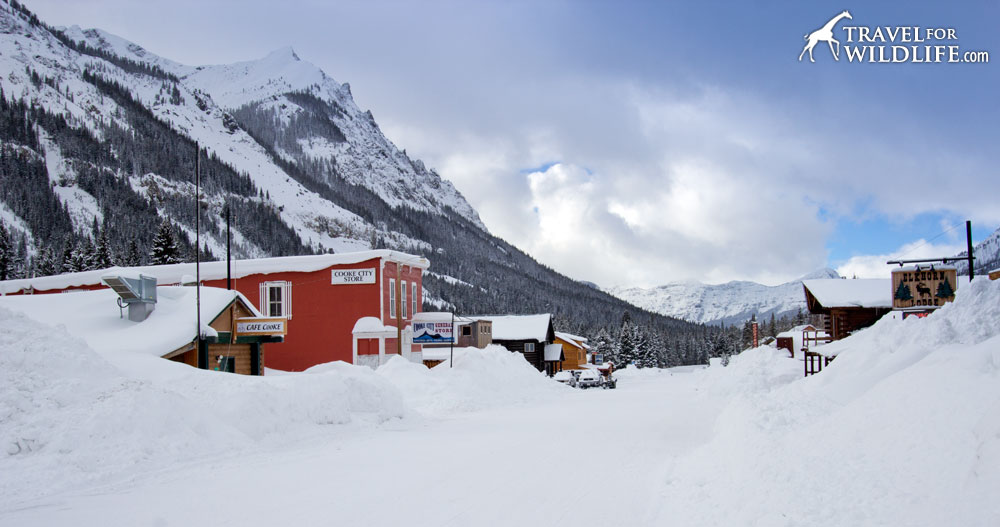
For dinner time, head to to the Bistro for pasta, seafood and steaks.
Cooke City locals call winter the “noisy season” as a huge number of snowmobiles take over the town. We didn’t find it very noisy but if you don’t like the idea of sharing your vacation with snowmobilers, Pine Edge Cabins has a few cute log cabins just down the road at Silver Gate. Silver Gate also has a couple of stores that are open in the winter months (last time we were there none were open), but no restaurants.
There are few other areas to stay in Yellowstone in winter. Inside the park we noticed the Mammoth Hot Springs Hotel and the Roosevelt Lodge were both open. Another small town option is the town of Gardiner at the north entrance. We find it a bit less charming than Cooke City and Silver Gate, but there are more services, some cheaper lodging options, and a slightly less wintery climate due to its lower elevation.
Spotting Scopes vs Binoculars for Watching Wolves in Yellowstone
When you drive around Yellowstone, you’ll see a lot of people with spotting scopes. This wildlife watching gear is normally reserved for birdwatchers. But now you are in Yellowstone where the visibility can literally be miles in every direction. Most of the time the wolves are so far away they’ll be nothing but dots moving on the mountain side.
While sometimes binoculars will suffice for wolf watching, a nice spotting scope will probably be your new favorite toy while watching wolves in Yellowstone.
It’s a tricky balance. With binoculars, it is easier to find wolves when they are on the move as you have a much wider field of vision. But if they are stationary and just hanging out, a spotting scope is a great asset. Only then will you be able to watch their behavior and antics and facial expressions.
In a perfect world, you would carry a pair of binoculars and a spotting scope. If you have a long lens on your SLR, then I would not buy a spotting scope. Because how many arms do you have to carry all your toys?
The good news is that you don’t have to buy a spotting scope. In fact, I would recommend you rent one and see how you like it. Try it before you buy it, right? You can rent a spotting scope from Wolftracker; they are based in Gardiner so you can just pick it up on your way down to the park and return it on your way back to Bozeman. If you are thinking about returning to Yellowstone in the future or if you are into birdwatching, then I would probably buy my own scope. In fact, I want one for next Christmas.
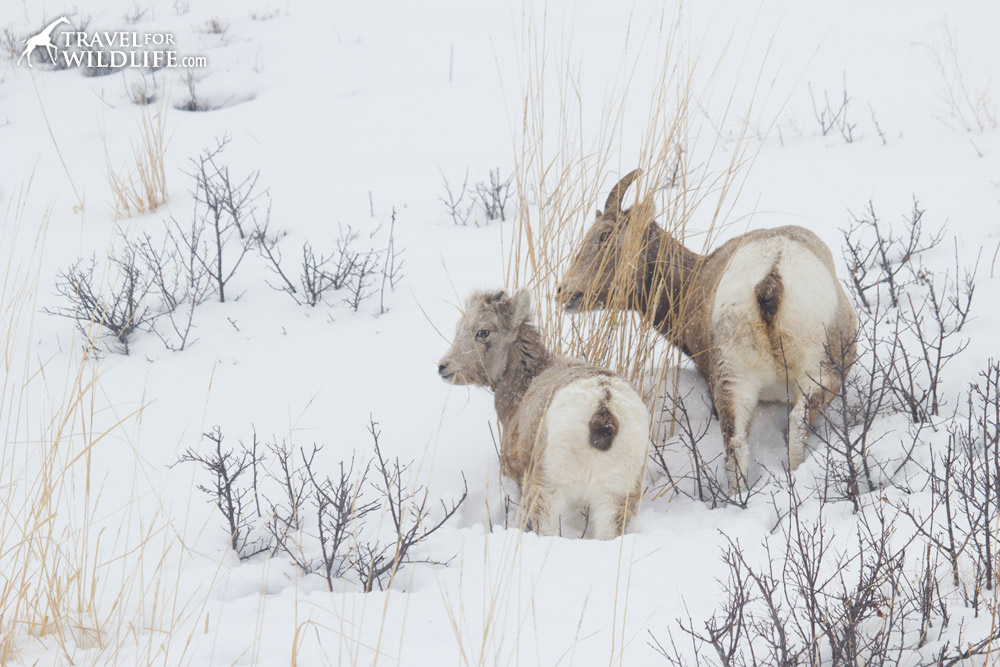
If you are on a budget, the Nikon Prostaff 5 Proscope 82mm Angled Body with 20-60x Zoom is a great choice. Affordable, with a big glass that will maximize the light gathering capability.
Next up on the lineup is the Bushnell Elite 20-60x 80mm 45-Degree Porro Prism Waterproof / Fogproof Spotting Scope, which also has a big glass (more light that comes in, the earlier in the day you can use it) and it is SLR camera-adaptable (which means that if you have the right adapter, you can screw your SLR and take photos through the scope).
At the top of the range (and wallet) is the Swarovski spotting scope. We did take a look through a Swarovski Optiks HD-ATS-80 HD Spotting Scope with 20×60 Eyepiece (Angled, 80mm) scope. The image was crisp and bright and it was fantastic to see the wolves’ facial expressions. The only negative thing is that they are more than double the price of the Bushnell.
Plus, remember you need to buy a tripod to put your scope on. So definitely rent one and try it out before you spend the money.
Etiquette when watching wildlife in Yellowstone:
Animals are always first. It doesn’t matter how great your photo would be. If your behavior changes their behavior, you need to change yours and step back. Yellowstone wildlife have a hard winter ahead and they need to survive. They should be using their energy to find food and shelter, not avoiding photographers. Please respect them.
If you see an elk standing in a river, do not approach it! Elk use rivers to avoid wolf attacks. They stand in the freezing water as they know wolves won’t venture in. Give them all the space they need to survive. Focus your energy in finding the nearby wolves and let the elk be.

Yellowstone is Easier Than You Think!
Yeah, really.
Pack your winter clothes, get on a plane, get your lens and have a winter adventure in Yellowstone!
DID YOU ENJOY THIS ARTICLE? PIN IT!
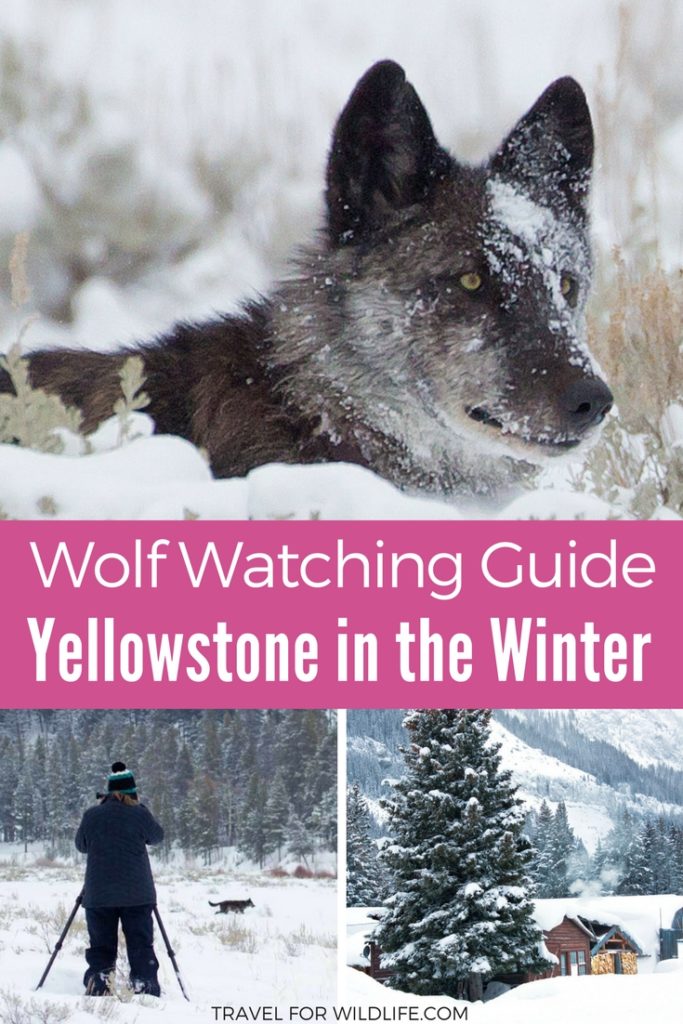

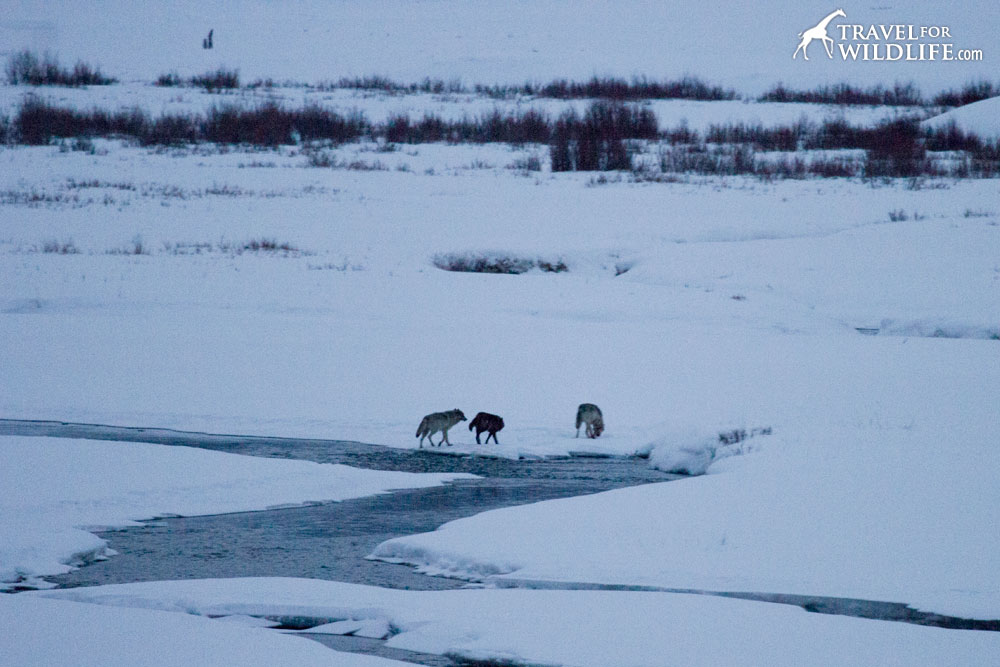
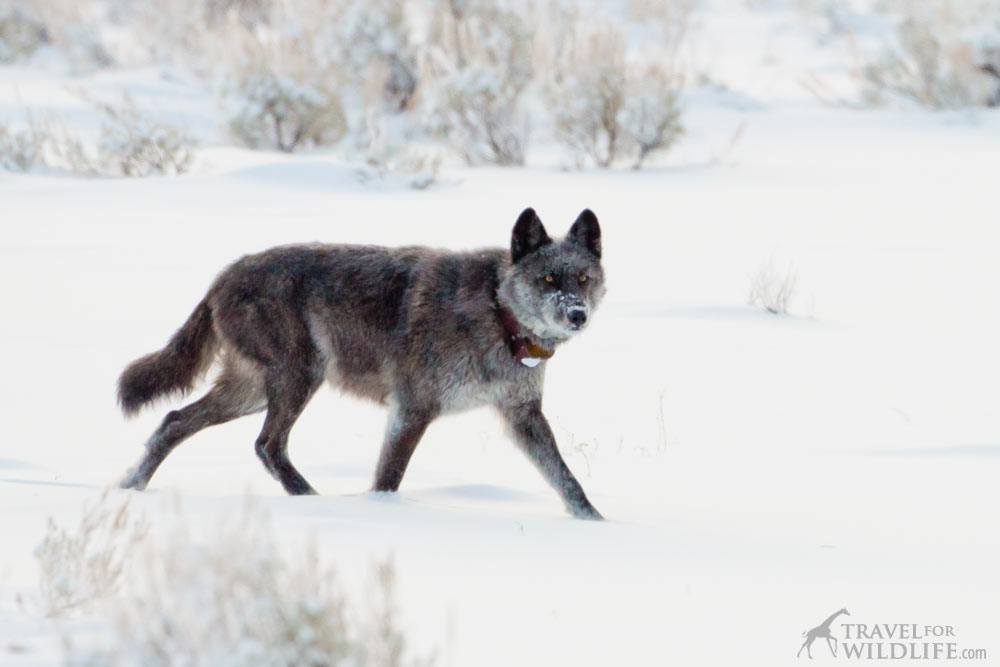
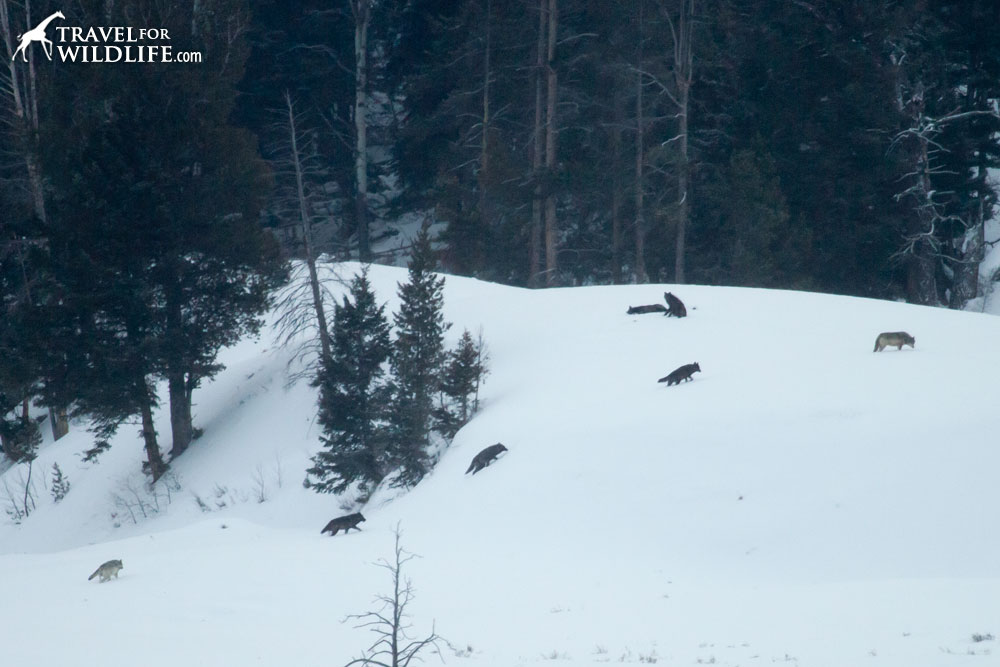
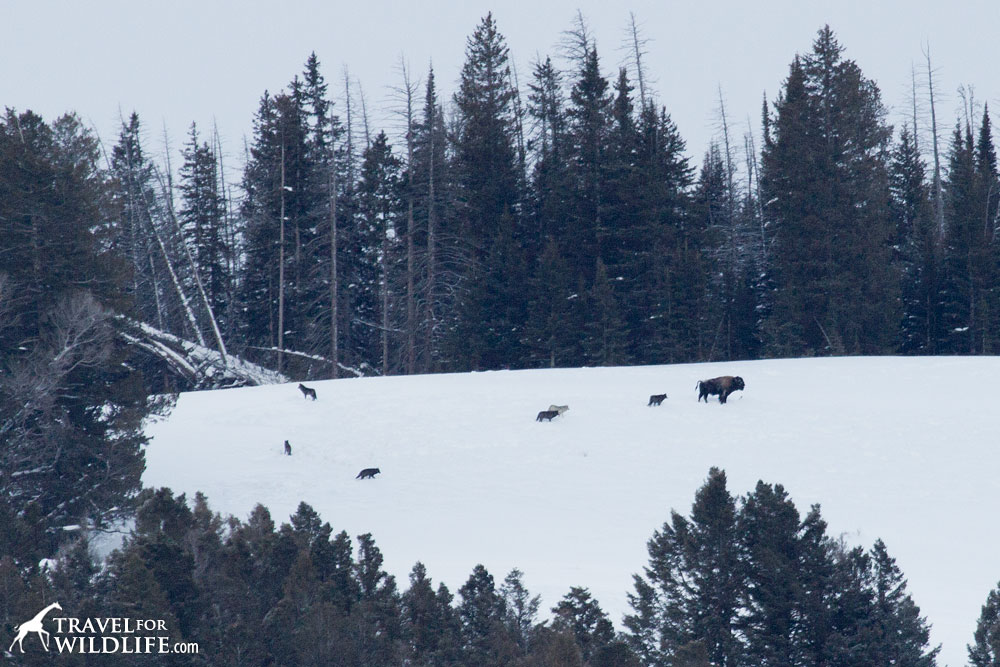
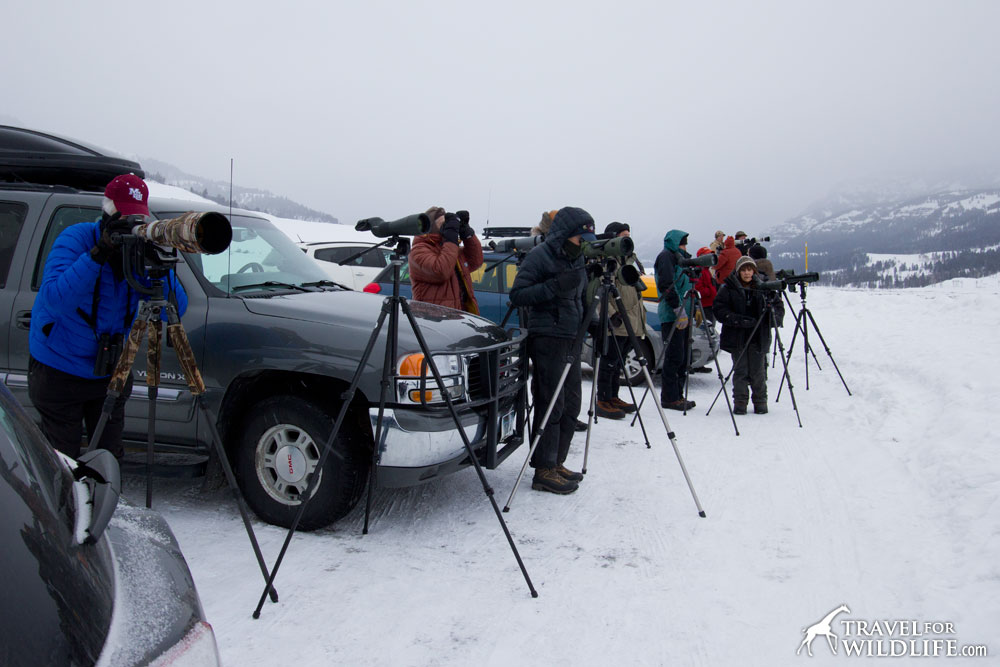
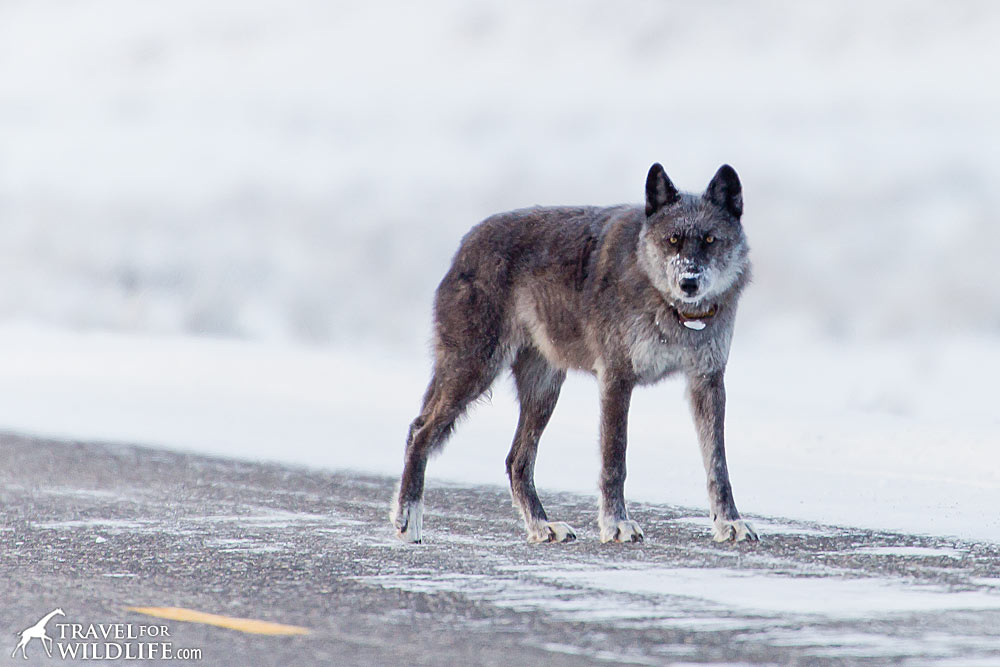
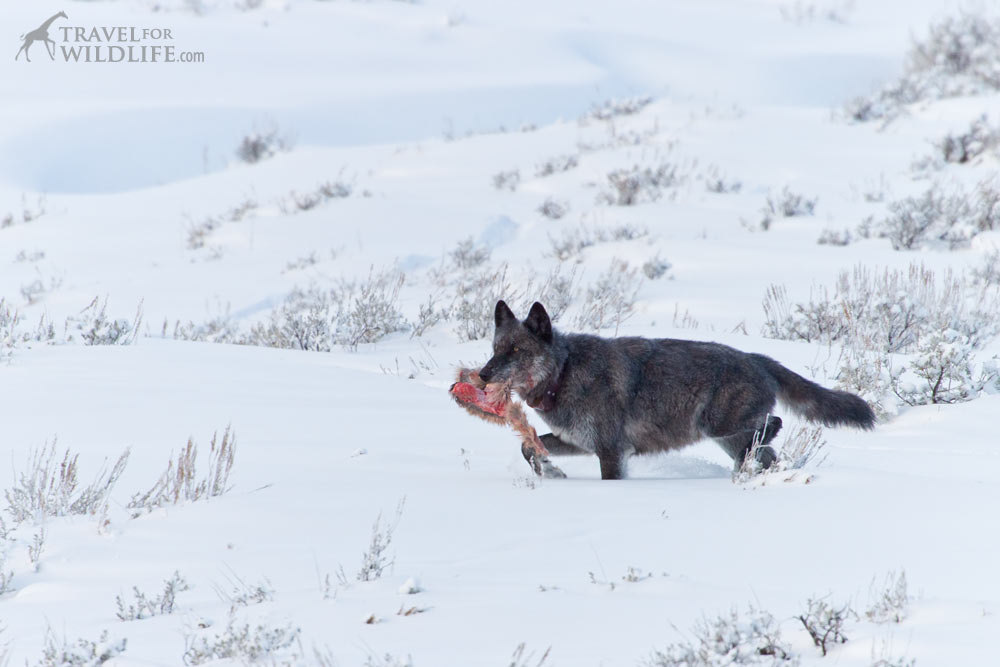
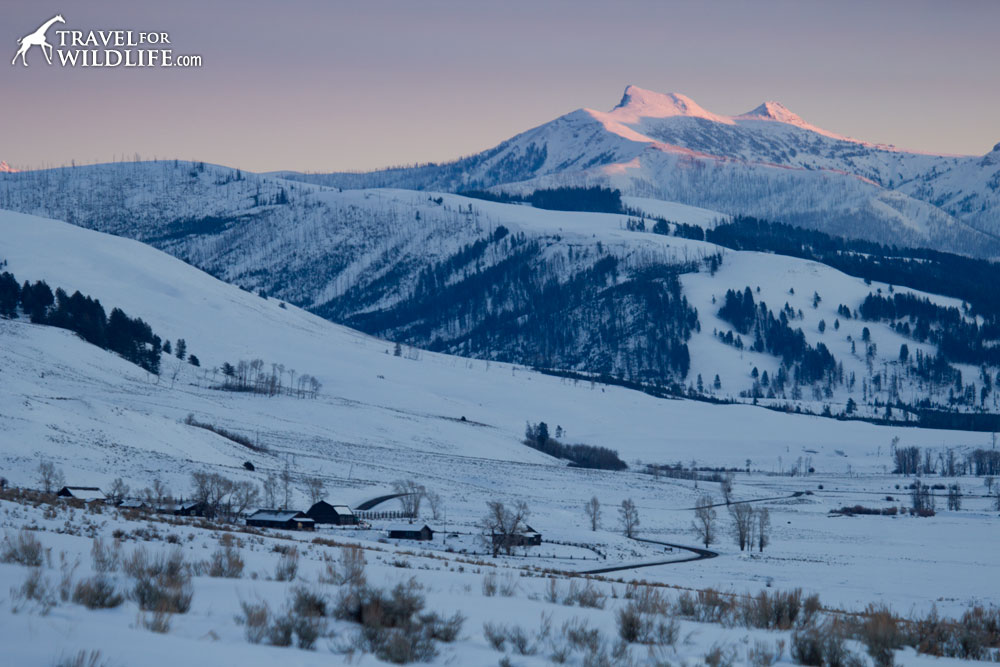

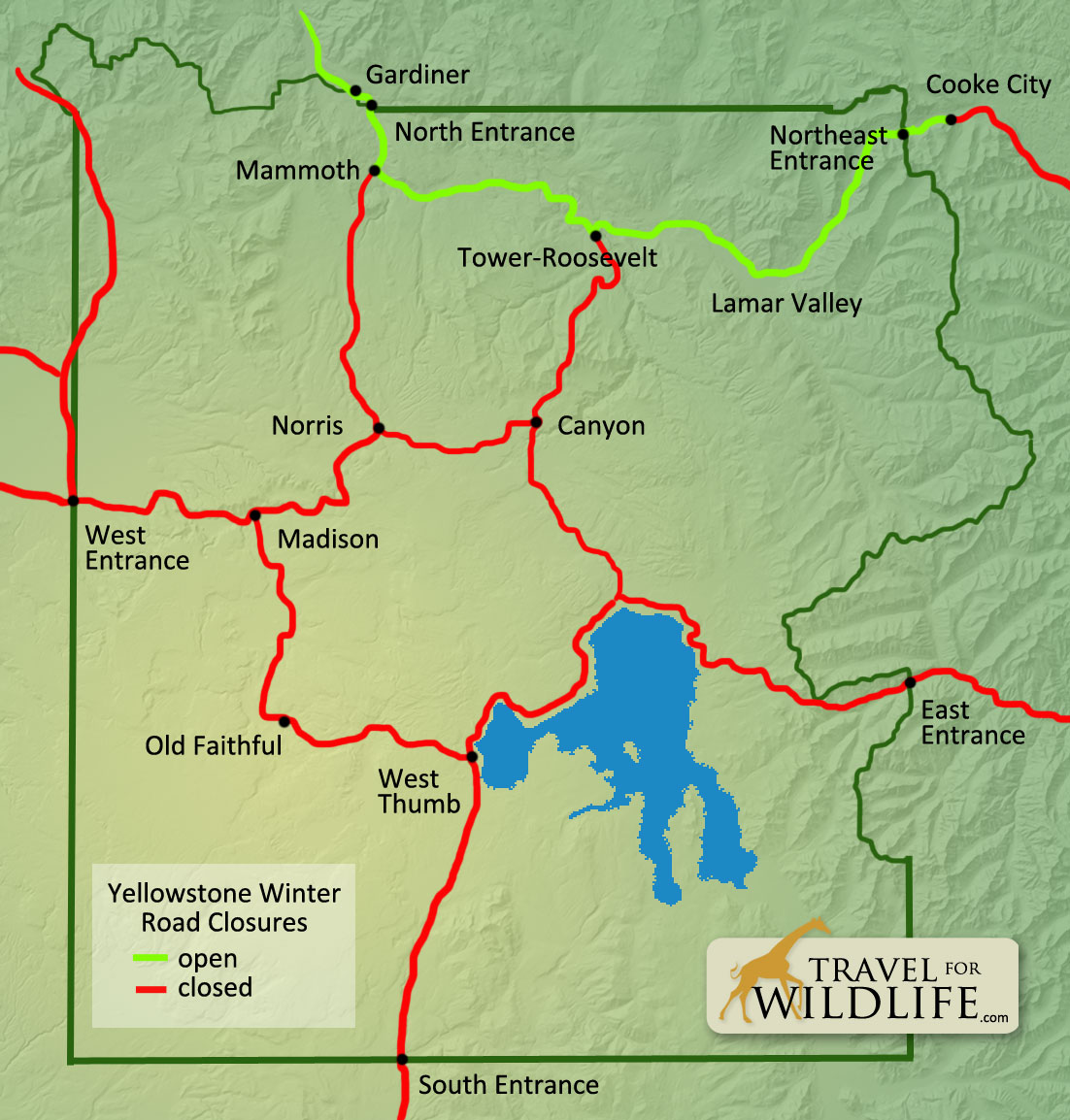
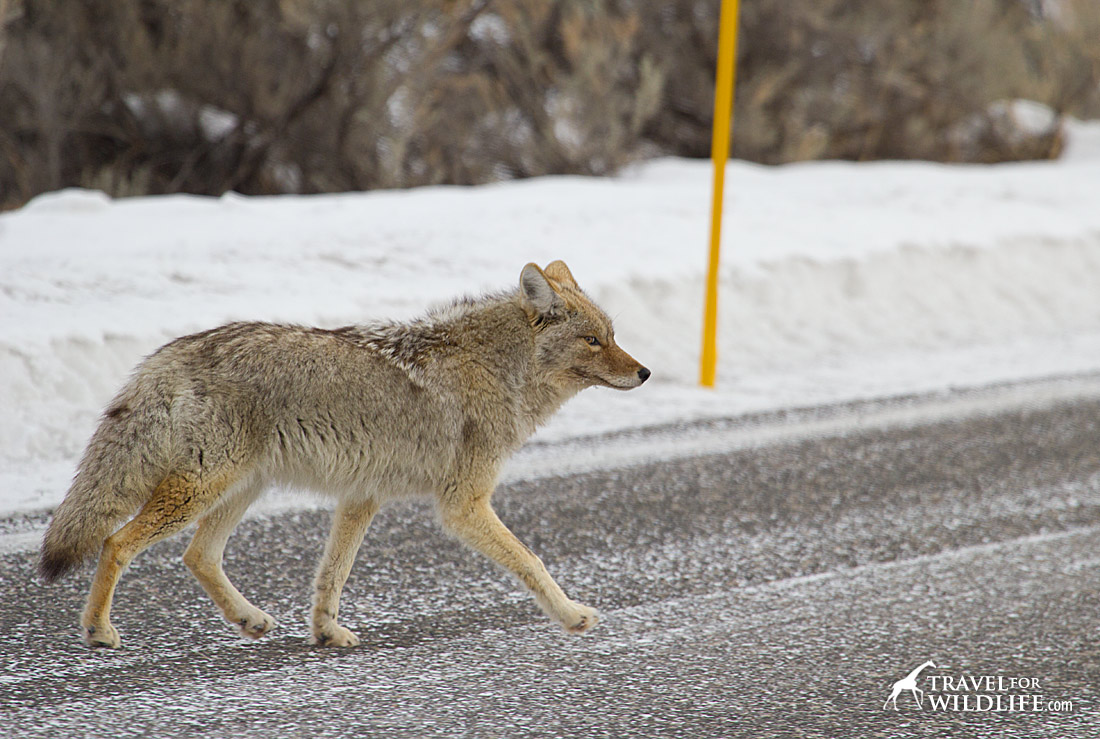
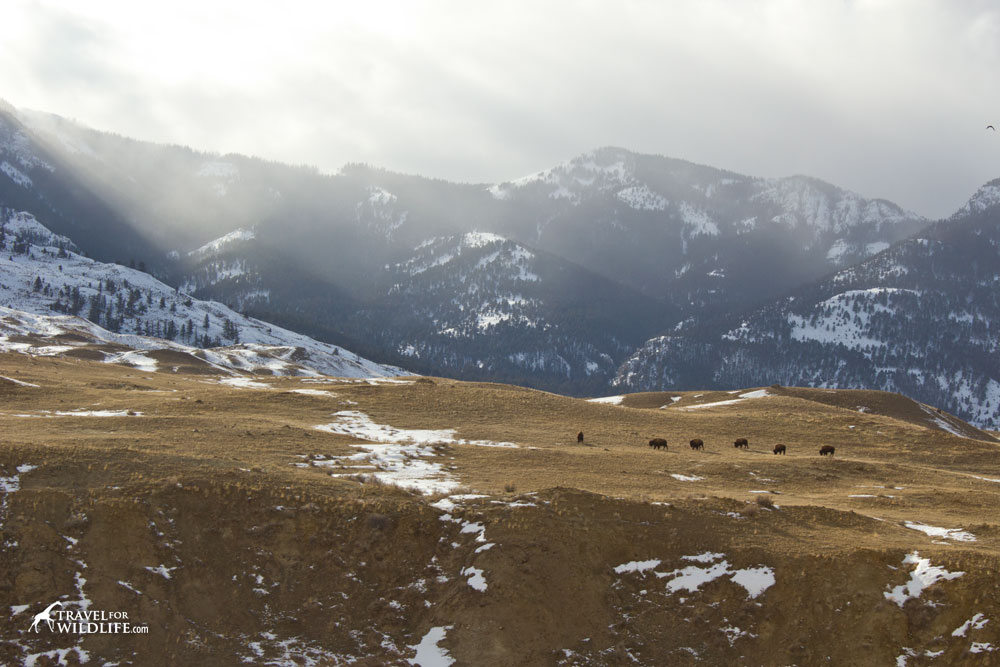
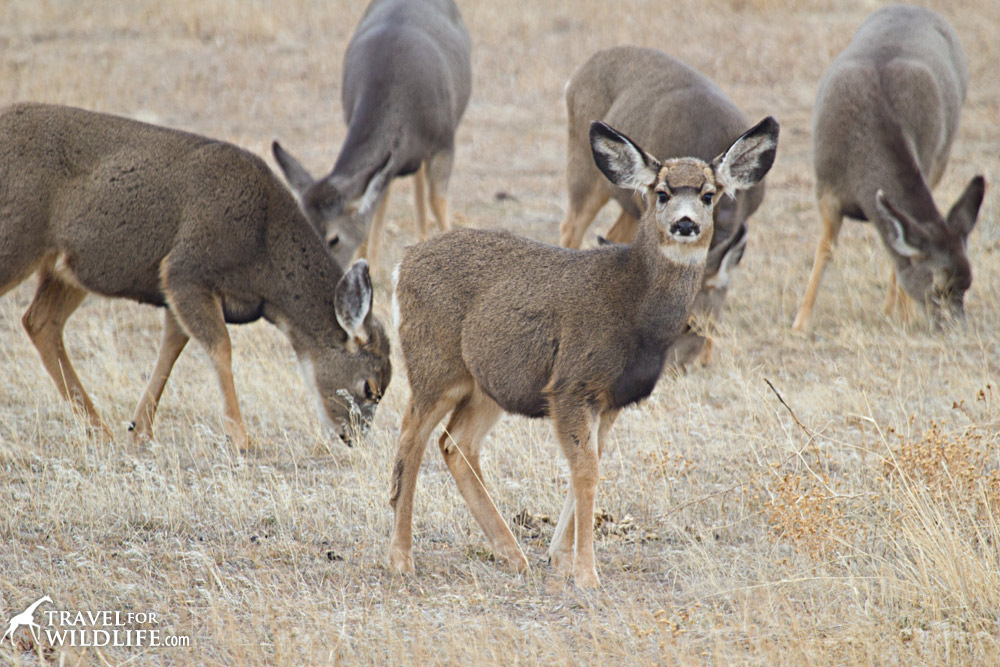
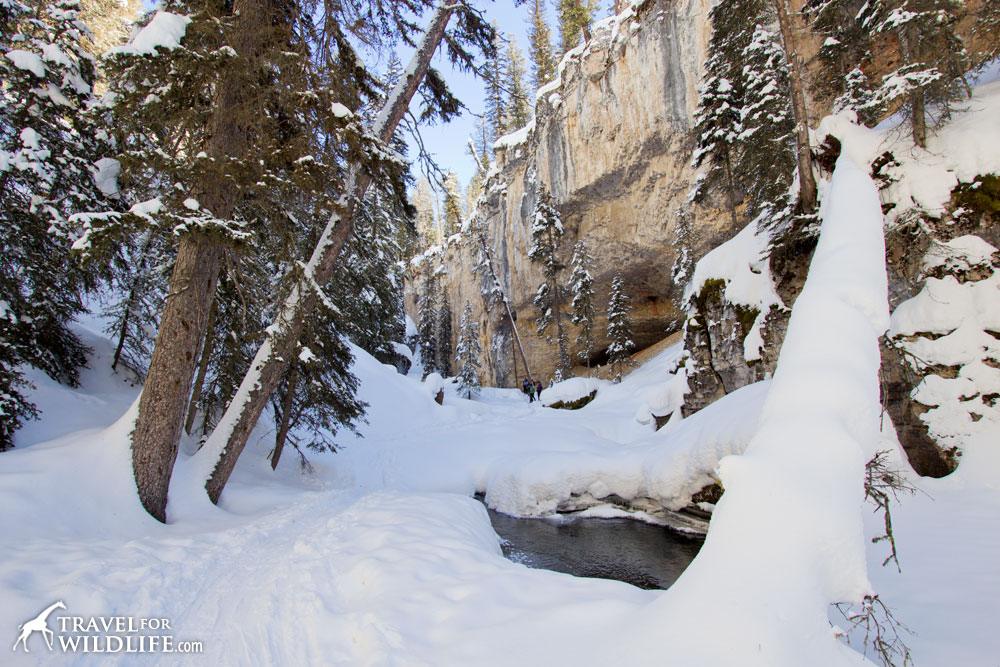
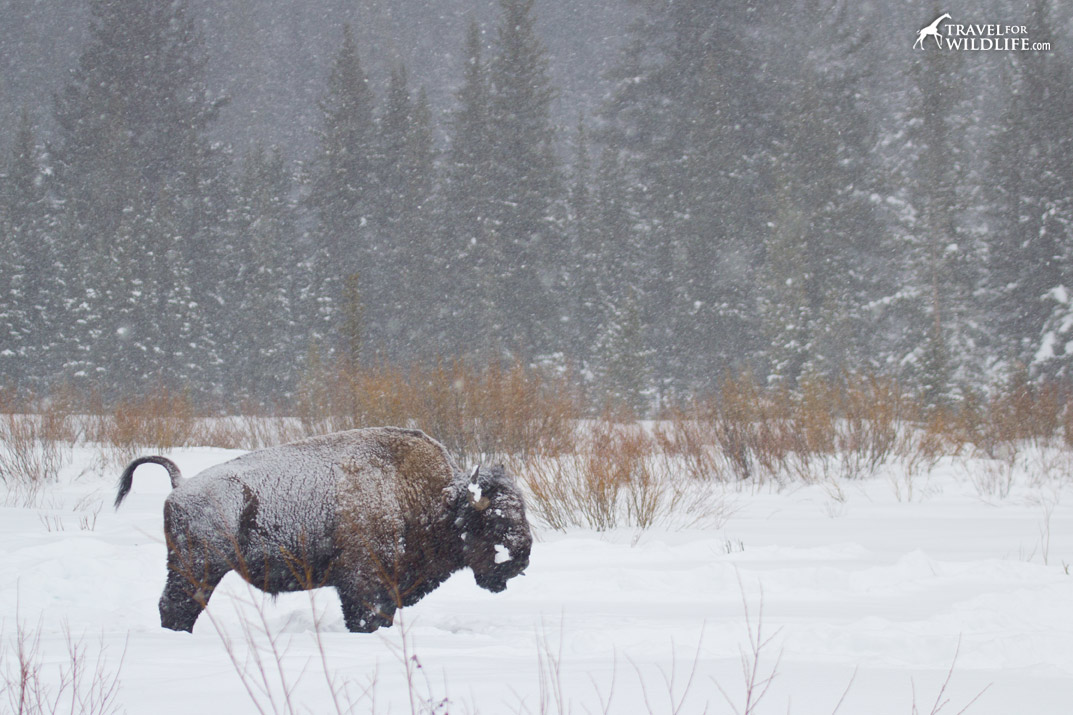
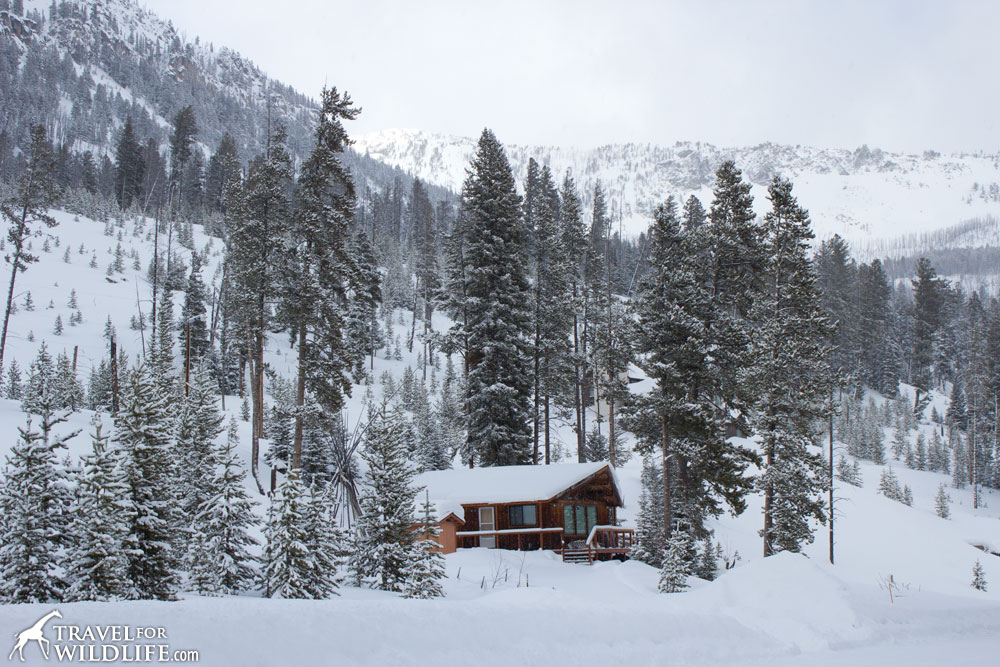
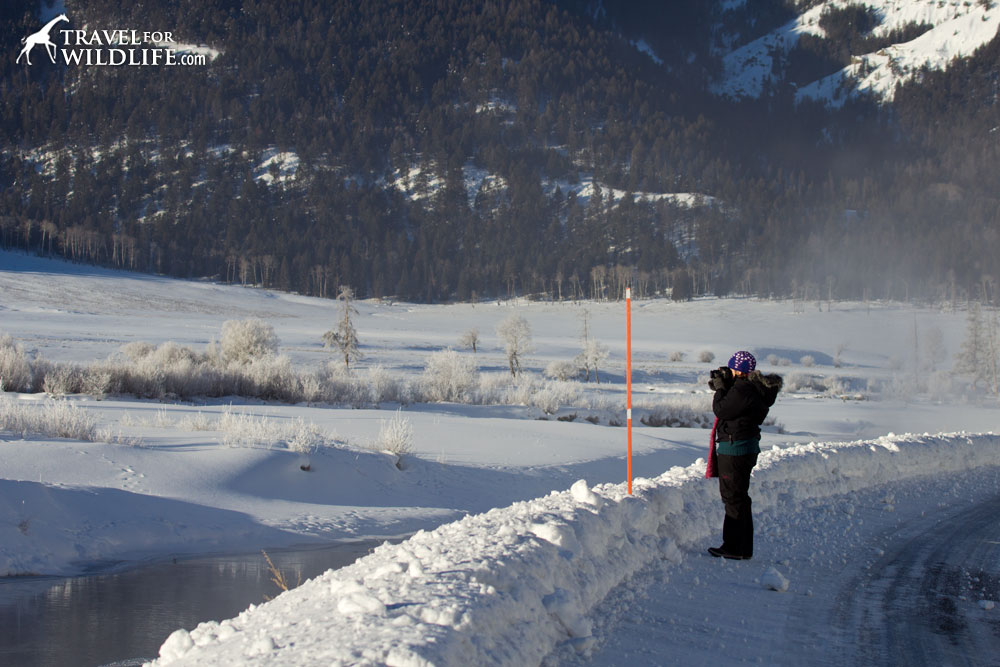

Jill
Monday 27th of June 2022
This is crazy. I don't think I would want to be close to these animals Thanks for sharing.
Masashi
Tuesday 29th of October 2019
Hi Cristina, This is the perfect article. Thank you so much!! I'm planning to visit Yellowstone in the winter, but do you think it is safe to bring my 10 months old son there?
Hal Brindley
Friday 22nd of November 2019
Hi Masashi, We just returned from another wintery visit to Yellowstone! We'll be making a companion article about visiting Yellowstone in November. As for bringing your 10-month old, I would say it is borderline. Sure you could all stay in the car the whole time with the heat cranking and you'd probably be fine. But with temperatures frequently reaching minus 20 in January and February (especially up toward Silver Gate), you wouldn't likely wouldn't want to spend much time out of the car with a young baby! Of course, that's entirely up to you. But half the fun is spending time outside watching the creatures. Another thing to consider is that if you get into an accident or slide off an icy road, it could be many hours before somebody is able to help you in the winter time. Then keeping yourself and your baby warm and fed/hydrated becomes a real concern! (Always drive with extra food, water, blankets, whatever you might need if you get stuck out there.) Is it safe to bring a baby in regards to the wild animals in Yellowstone? Of course! As long as you keep your baby with you at all times! We hope you enjoy your trip, whatever you decide! -Hal
Laura
Friday 27th of February 2015
This is a great resource. So amazing that you guys got to see the wolves there. I'm going to be in Jackson Hole in July for work and my plan is to spend at least one night near the Lamar Valley to try to see the wolves as well. Thanks for the recommendation of the tour company, going to check them out!
Cristina Garcia
Saturday 28th of February 2015
Thanks Laura! Yes, check out Nathan and his team of guides. They are really great. Let us know how your trip goes and hope you see the wolves! (remember: wake up super early!)
Jill
Tuesday 10th of February 2015
AMAZING article. Great tips and photos. I can't wait to see Yellowstone in the winter. Too bad you didn't get a chance to try Miners Saloon, but that's just another reason to go back!
Cristina Garcia
Tuesday 10th of February 2015
I know, we were (we always are!) on a very tight budget and ate salads back at our motel. Except for the amazing breakfast at the Beartooth on our last day in the park. We had to celebrate with a real coffee! Next January I hope to be able to go to Miners Saloon, it looked really great!
Cristina Garcia
Monday 9th of February 2015
Thanks Ted! We did came across a few cross-country skiers when we hiked up Pebble Creek. We saw other skiers trails covering other hiking trails. So, yep, bring your gear! (and your fanny pack too!)